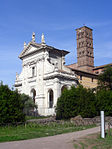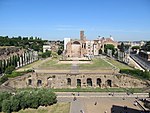Via dei Fori Imperiali
Imperial forums of RomeItalian fascist architectureOdonyms referring to a buildingStreets in Rome R. I Monti

The Via dei Fori Imperiali (formerly Via dei Monti, then Via dell'Impero) is a road in the centre of the city of Rome, Italy, that runs in a straight line from the Piazza Venezia to the Colosseum. Its course takes it over parts of the Forum of Trajan, Forum of Augustus and Forum of Nerva, parts of which can be seen on both sides of the road. Since the 1990s, there has been a great deal of archeological excavation on both sides of the road, as significant Imperial Roman relics remain to be found underneath it.
Excerpt from the Wikipedia article Via dei Fori Imperiali (License: CC BY-SA 3.0, Authors, Images).Via dei Fori Imperiali
Piazza di Santa Francesca Romana, Rome Municipio Roma I
Geographical coordinates (GPS) Address Nearby Places Show on map
Geographical coordinates (GPS)
| Latitude | Longitude |
|---|---|
| N 41.891944444444 ° | E 12.489166666667 ° |
Address
Basilica di Massenzio
Piazza di Santa Francesca Romana
00184 Rome, Municipio Roma I
Lazio, Italy
Open on Google Maps








